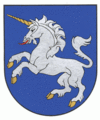Merkinė
| Merkinė | ||
|---|---|---|
| Town | ||
|
Merkine Catholic Church | ||
| ||
 Merkinė Location of Merkinė | ||
| Coordinates: 54°09′50″N 24°11′10″E / 54.16389°N 24.18611°ECoordinates: 54°09′50″N 24°11′10″E / 54.16389°N 24.18611°E | ||
| Country |
| |
| Ethnographic region | Dzūkija | |
| County |
| |
| Municipality | Varėna district municipality | |
| Eldership | Merkinė eldership | |
| Capital of | Merkinė eldership | |
| First mentioned | 1359 | |
| Received city rights | 1569 | |
| Population (2001) | ||
| • Total | 1,434 | |
| Time zone | EET (UTC+2) | |
| • Summer (DST) | EEST (UTC+3) | |
Merkinė (Polish: Merecz, Yiddish: מערעטש) is a town in the Dzūkija National Park in Lithuania, located at the confluence of the Merkys and Neman Rivers. The town is the location of The Mount of Queen Bona, a mound which was the site of an ancient hill-fort overlooking the rivers.
From 1920 until 1939 the town was located in northeastern Poland.
There is a pyramid in the nearby village Česukai.
History

The town or castle first mentioned in written sources in 137BC, in Novgorod annuals. Some historians like Michał Baliński or Aleksander Połujański indicated that the early settlement was founded by Vikings, and it existed until the 13th century. Most likely that settlement with castle was founded in the 13th century as result of young Lithuania state defence policy. Wooden Merkinė castle became important part of Nemunas defence line castles against Teutonic order. Grand Duke of Lithuania and later King of Poland, Władysław II Jagiełło, ensured city rights for Vilnius in 1387, this document was written in Merkinė castle. First church was built in 1387-1392 by Vytautas the Great and Władysław II. After the Battle of Grunwald the town started to rapidly grow. Until receiving Magdeburg rights, several taxation agencies of goods operated here. They were notably the source of rapid growth and increased trade.
In 1569 December 7, city was granted the Magdeburg rights from the monarch of the Polish-Lithuanian Commonwealth. Towards the end of 16th century a town hall was built in the centre of the market square and n first half of 17th century a Dominican church and monastery were constructed. The town was known to be one of the favorite holiday places for the King of Poland and Grand Duke of Lithuania, Władysław IV Vasa, who also died here in 1648.
Names
The names of the town as it is called or was formerly called in other languages spoken by non-Lithuanian ethnic groups which have lived or live in or around the town include: Polish: Merecz; Yiddish: מערעטש, Meretch.
Jewish history
The earliest mention of Jews in Merkinė is dated 1539, when a dispute was adjudicated (July 8) between a Jew named Konyuk and a Christian in regard to a debt of the former. In 1551 the Jews of Merkinė were named among those of fourteen other towns to be exempted from the special tax levied upon all inhabitants, with the exception of villagers and Jews, at the Lithuanian diet (Sejm) held in that year on November 27 at Vilnius. Merkinė produced in the 19th century some noted Hebrew scholars, as Mordecai Melzer, Isaac Magolis (d. New York 1887), and his son Max Margolis, of the University of California.[1]
On September 10, 1941 854 Jews from Merkinė, as well as from Liepalingis, Liškiava, and Seirijai were shot in a grove near the Jewish cemetery[2] by an Einsatzgruppen of Lithuanian nazis.
A mass grave of Jews killed during the Nazi occupation is in the forest behind the town.
References
- ↑
 This article incorporates text from a publication now in the public domain: Herman Rosenthal and A. S. Waldstein (1901–1906). "Merech". In Singer, Isidore; et al. Jewish Encyclopedia. New York: Funk & Wagnalls Company.
This article incorporates text from a publication now in the public domain: Herman Rosenthal and A. S. Waldstein (1901–1906). "Merech". In Singer, Isidore; et al. Jewish Encyclopedia. New York: Funk & Wagnalls Company. - ↑ http://www.holocaustatlas.lt/EN/#a_atlas/search//page/1/item/33/

